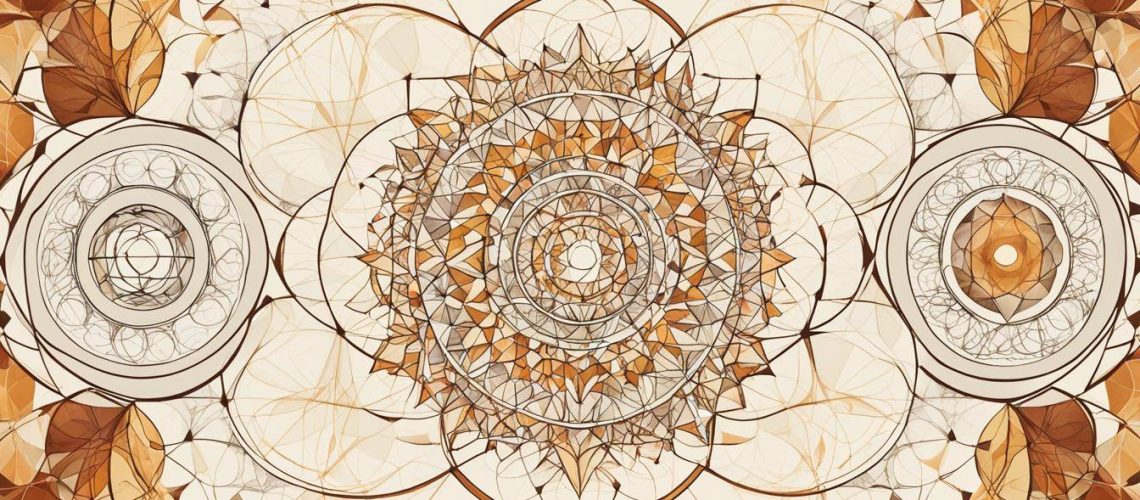Have you ever marveled at the intricate patterns found in nature? From the delicate symmetry of flower petals to the spiraling perfection of seashells, there is an undeniable beauty and harmony that exists in the natural world. But did you know that these patterns hold a deeper significance?
In this article, we will explore the fascinating relationship between sacred geometry and the patterns of nature. Prepare to embark on a journey into the realm of divine design and mystical connection, where ancient wisdom and modern science intersect.
Through the exploration of geometric symbolism and mathematical principles, we will shed light on the profound meanings behind these intricate patterns. Get ready to unravel the secrets of the golden ratio, discover the healing power of sacred geometry, and explore how these ancient principles can be applied in everyday life.
So, are you ready to dive into the world of sacred geometry and unravel the mysteries of nature’s sacred design? Let’s begin!
Key Takeaways:
- Sacred geometry is the study of geometric patterns and symbols that hold deep symbolic and spiritual meaning.
- Nature utilizes geometry in its designs, reflecting an inherent balance and harmony.
- The golden ratio is a mathematical proportion found in nature and various art forms.
- Sacred geometry art communicates profound spiritual and symbolic meanings through geometric shapes and patterns.
- Mathematics and symmetry are fundamental to understanding the patterns and shapes in the natural world.
An Introduction to Sacred Geometry
To truly understand the intricate patterns found in nature, it is essential to familiarize ourselves with the concept of sacred geometry. This ancient practice explores the spiritual and mathematical aspects of the universe through the use of geometric shapes and symbols.
Sacred geometry is a profound system that recognizes the interconnection between the physical and the spiritual realms. It delves deep into the symmetrical and harmonious patterns that exist throughout the cosmos, from the tiniest atoms to the vast galaxies.
Geometric symbolism plays a fundamental role in sacred geometry, with each shape and symbol carrying its own unique meaning and significance. These geometric forms have been used for centuries to convey complex ideas and represent the divine order present in our world.
By studying sacred geometry, we gain insight into the underlying structure and design of the universe. It allows us to perceive the beauty and intricacy that exists in everything around us, from the blossom of a flower to the spirals of a seashell.
“Geometry is the archetype of the beauty of the world.” – Johannes Kepler
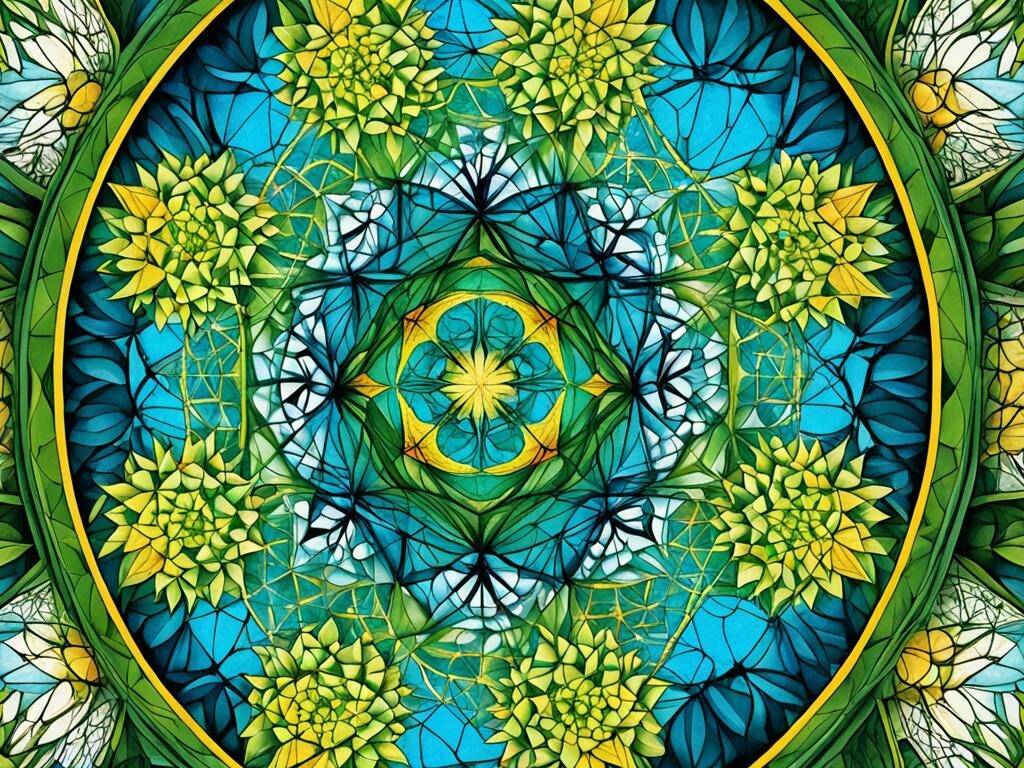
Common Geometric Symbols and Their Meanings
| Symbol | Meaning |
|---|---|
| Circle | Unity, wholeness, eternity |
| Spiral | Growth, evolution, transformation |
| Triangle | Balance, harmony, manifestation |
| Flower of Life | Creation, interconnectedness, divine pattern |
| Metatron’s Cube | Sacred geometry grid, balance of masculine and feminine energies |
Sacred geometry holds the key to unlocking the profound mysteries of our existence. It serves as a bridge between the physical and the metaphysical, offering a glimpse into the divine designs that govern our world.
By delving into the rich symbolism and profound meanings of sacred geometry, we embark on a journey of exploration and discovery. Through the study of these timeless patterns, we gain insight into the interconnectedness of all things and deepen our connection to the universe.
The Role of Geometry in Nature
In the intricate tapestry of the natural world, geometry weaves a harmonious thread. From the delicate symmetry of a flower petal to the spiraling patterns of seashells, nature effortlessly showcases the beauty and elegance of geometric design. Natural patterns in design, nature-inspired geometry, and symbolic geometry in nature all play a vital role in creating balance and enhancing the vitality of our environment.
When we observe the natural world closely, we can witness a myriad of geometric patterns that appear time and time again. These patterns are not mere coincidences but instead reflect a deep-rooted connection between geometry and nature. It is through these patterns that nature achieves both functionality and aesthetic appeal.
One example of nature’s affinity for geometry can be found in the petals of flowers. The arrangement of petals often follows specific patterns, such as the Fibonacci sequence, creating a visually stunning display of natural symmetry and balance. This inherent geometry not only attracts pollinators but also ensures efficient seed production and reproduction.
Another fascinating example of geometry in nature is seen in the hexagonal cells of bee hives. Bees construct their hives using hexagonal cells due to the efficiency and space optimization provided by this shape. The hexagon allows bees to maximize the storage and structural integrity of the hive, showcasing nature’s innate understanding of mathematical principles.
“Geometry is the language of the universe. It is the key to unlocking the mysteries of the natural world.” – Leonardo da Vinci
The utilization of geometry in nature goes beyond mere functionality; it also carries deep symbolic significance. Certain shapes and patterns found in nature hold cultural and spiritual meanings that have been passed down through generations. For example, the spiral pattern often seen in seashells represents growth, expansion, and the cycle of life. This symbolic geometry in nature reflects the interconnectedness and cyclical nature of the universe.
By understanding and appreciating the role of geometry in nature, we gain a deeper appreciation for the world around us. We realize that these intricate patterns are not random occurrences but are the result of millions of years of evolution and adaptation. Nature-inspired geometry invites us to explore the beauty of the natural world and find inspiration in its stunning designs.

As we continue to uncover the secrets of geometric patterns in nature, we unlock new realms of knowledge and inspiration. The study of natural patterns in design, nature-inspired geometry, and symbolic geometry in nature offers us a glimpse into the remarkable intelligence and design present in every corner of our world.
The Golden Ratio and Divine Proportions
Unlock the mysteries of the divine proportions and the golden ratio — a mathematical ratio that possesses both aesthetic appeal and a ubiquitous presence in the natural and man-made creations of our world.
The golden ratio, often represented by the symbol φ (phi), is an irrational number approximately equal to 1.6180339887. It is a mathematically significant proportion believed to be aesthetically pleasing to the human eye. Revered since ancient times, this divine proportion can be found in various aspects of our lives, including nature, art, and architecture.
One of the prominent examples of the golden ratio in nature is its presence in the growth patterns of plants. The arrangement of leaves, petals, and branches often follows this geometric principle, leading to the visually pleasing and harmonious forms we find in foliage. This natural occurrence of the golden ratio is believed to contribute to the overall beauty and balance of plant life.
Similarly, the human body also exhibits the golden ratio in certain proportions. From the ratio of the height of our heads to the total height of our bodies, to the divisions in our fingers and limbs, traces of the golden ratio can be found. It is theorized that the presence of this proportion contributes to our perception of beauty and symmetry.
In the world of art and architecture, the golden ratio has played a significant role throughout history. Many renowned artworks and architectural masterpieces, such as the Parthenon in Athens and Leonardo da Vinci’s “The Last Supper,” have been found to incorporate the golden ratio in their composition. This intentional use of divine proportions adds a sense of harmony and balance to these creations, elevating them to a higher aesthetic level.
Here is a visual representation of the golden ratio:
| Golden Ratio | Approximate Value |
|---|---|
| φ | 1.6180339887 |
Note: The golden ratio is an irrational number and goes on indefinitely.
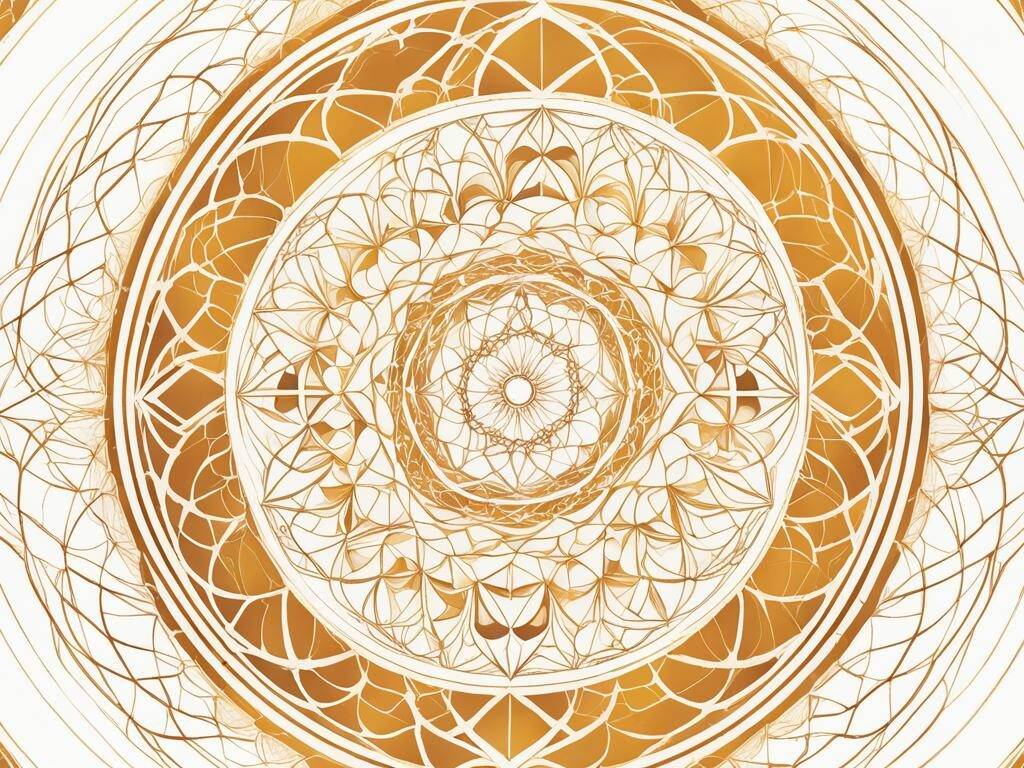
Divine Proportions in Famous Works of Art and Architecture
The application of the golden ratio can be observed in several iconic works of art and architecture. Below are a few notable examples:
- Leonardo da Vinci’s Vitruvian Man: This famous sketch showcases the application of the golden ratio in the proportions of the human body.
- The Parthenon: The ancient Greek temple in Athens embodies the use of divine proportions in its architecture, resulting in a sense of balance and harmony.
- The Great Pyramid of Giza: Although not mathematically precise, the proportions of the Great Pyramid align closely with the golden ratio, showcasing the ancient Egyptians’ understanding of geometric harmony.
“The golden ratio is nature’s secret to achieving perfect harmony and beauty in design.”
As we delve deeper into the world of sacred geometry, the golden ratio and divine proportions serve as reminders of the interconnectedness between mathematics and nature. By recognizing and embracing these mathematical principles, we gain a greater appreciation for the inherent beauty and harmony present in our surroundings.
Sacred Geometry Art and Symbolism
Step into the enchanting world of sacred geometry art, where artists utilize geometric shapes and patterns to convey profound spiritual and symbolic meanings. These intricately crafted artworks have the power to resonate with viewers on a deep and soulful level, evoking a sense of awe and connection to the divine.
Sacred geometry art is a visual language that transcends cultural boundaries, drawing inspiration from the inherent geometric patterns found in nature. By incorporating these sacred geometrical principles into their creations, artists tap into a universal language that speaks to the interconnectedness of all things.
Through the intricate interplay of geometric shapes, symbolic geometry in nature becomes a visual journey that invites contemplation and self-reflection. The repetitive patterns and harmonious compositions in sacred geometry art mirror the beauty and order found in the natural world, reminding us of the inherent balance and unity that permeates the universe.
The Symbolic Language of Sacred Geometry Art
Sacred geometry art encompasses a diverse range of mediums, from paintings and sculptures to jewelry and architectural designs. Each piece tells a unique story, holding layers of symbolic meaning that can be interpreted in various ways.
“Sacred geometry is a gateway to understanding the universal principles that govern our existence. Through artistic expression, we can tap into the realm of the unseen and unveil profound truths about ourselves and the world around us.”
With its roots deeply embedded in ancient wisdom traditions and philosophical teachings, sacred geometry art carries with it an aura of mystery and intrigue. The precise geometrical arrangements within these artworks, such as the Flower of Life or Metatron’s Cube, hold specific symbolic significance that can evoke feelings of harmony, growth, and spiritual awakening.
The Power of Symbolic Geometry in Nature
The use of symbolic geometry in nature is not limited to art alone. It can also be observed in the world around us, revealing a profound connection between human consciousness and the natural world.
From the mesmerizing patterns of a nautilus shell to the intricate symmetry of a snowflake, nature has perfected the art of sacred geometry. These innate geometric patterns serve as a reminder that the universe is not merely a chaotic collection of random events but rather a masterpiece of divine design.
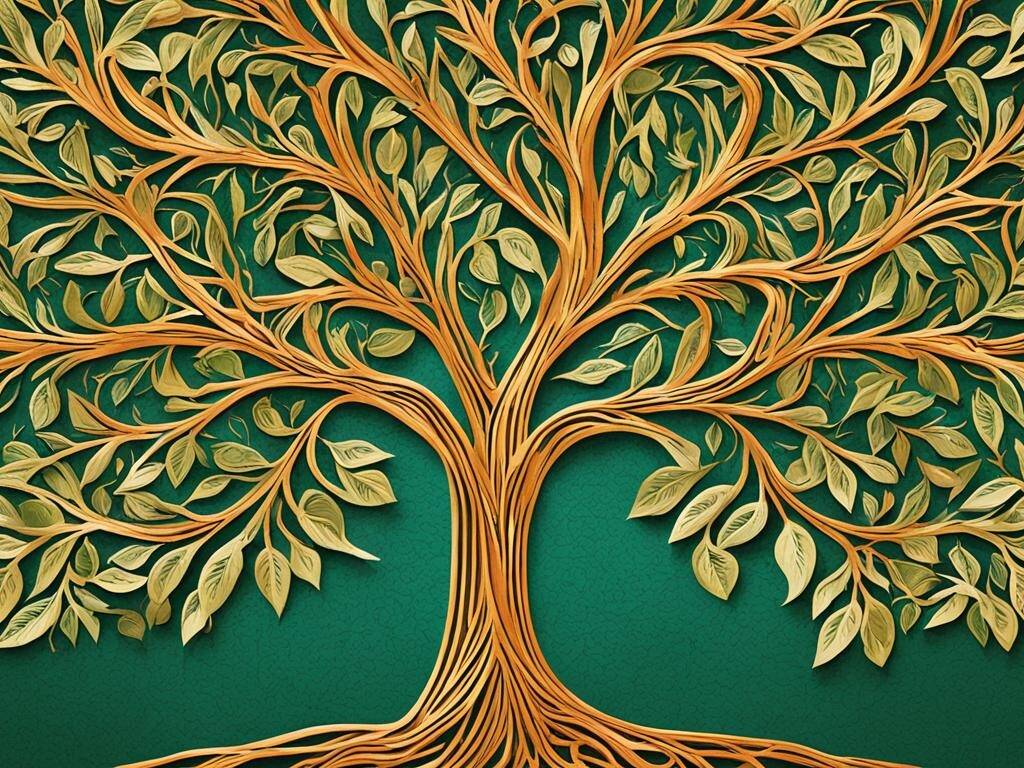
| Symbolic Geometric Pattern | Natural Example |
|---|---|
| Golden Ratio | Spiral patterns in sunflowers |
| Seed of Life | Cell division and growth |
| Vesica Piscis | The eye of a peacock’s feather |
| Merkaba | The shape of a snowflake |
These natural examples of symbolic geometry not only captivate our senses but also offer a glimpse into the underlying mathematical principles that govern the universe. They remind us that we are intricately connected to the fabric of existence and that there is a profound order and beauty encoded within every aspect of life.
As we immerse ourselves in the world of sacred geometry art and explore the symbolic geometry in nature, we embark on a journey of discovery and self-transformation. Through these artistic expressions and natural wonders, we are reminded of the timeless wisdom that echoes throughout the cosmos, inviting us to contemplate our place within the grand tapestry of creation.
Mathematics and Symmetry in Nature
When we observe the natural world around us, we can’t help but marvel at the intricate patterns and harmonious shapes that manifest in various forms. Mathematics and symmetry are at the very core of these awe-inspiring phenomena, revealing a profound connection between the abstract realm of numbers and the tangible realm of nature.
One striking example of mathematics in nature is found in the spirals of seashells. These shells exhibit a perfect logarithmic spiral pattern known as the Fibonacci spiral, which is derived from the Fibonacci sequence. This sequence, where each number is the sum of the two preceding numbers (0, 1, 1, 2, 3, 5, 8, 13, and so on), describes the growth pattern of many living organisms, including the arrangement of seeds in a sunflower or the branching of a tree.
Another fascinating manifestation of mathematics in nature is seen in the fractal patterns of ferns. Fractals are self-repeating geometric shapes that exhibit intricate detail at every level of magnification. They are created through simple mathematical equations but result in complex and infinitely complex patterns. In the case of ferns, each leaflet is a miniature replica of the entire frond, forming a beautiful fractal structure.
These natural patterns and geometric shapes go beyond mere aesthetics. They serve essential functions in the ecosystem, ensuring efficiency, sustainability, and beauty in the natural world. The mathematical principles underlying these patterns help organisms optimize processes such as resource allocation, energy distribution, and reproduction.
Mathematics is not only abstract formulas and equations confined to the classroom. It is ingrained in the very fabric of our existence, evident in the elegant symmetries and geometric patterns that define the world around us.
By studying and appreciating the mathematics and symmetry in nature, we gain a deeper understanding of the underlying order and interconnectedness of all living things. It highlights the beauty of the universe’s design and invites us to contemplate the mysteries and wonders that surround us.
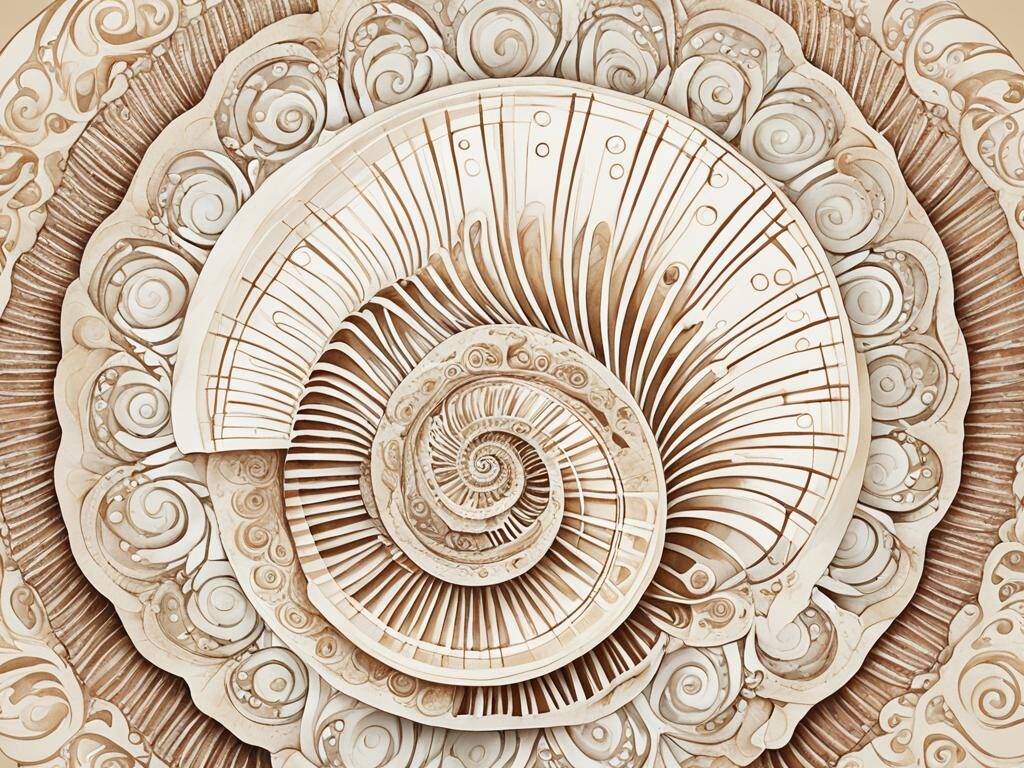
The Significance of Symmetry
Symmetry, a fundamental concept in mathematics, is also abundant in nature. Symmetrical structures are not only visually appealing but also indicate balance and stability. They can be found in the radial symmetry of flowers, the bilateral symmetry of animals, and even the crystalline structures of minerals.
Plants and flowers often exhibit radial symmetry, where their petals radiate from a central point. This symmetry allows for efficient access to sunlight and pollinators from any direction. The stunning beauty of flowers, such as sunflowers and daisies, can be attributed to the precise arrangement and symmetry of their petals.
On the other hand, many animals, including humans, display bilateral symmetry. This means that their bodies can be divided into two nearly identical halves, mirroring each other along a central axis. Bilateral symmetry contributes to improved mobility and coordination, enabling organisms to navigate their environment with ease.
The prevalence of symmetry in nature demonstrates the inherent order and balance that permeates the natural world. It is a reminder that mathematics is not separate from nature but an integral part of its fabric, shaping the forms, patterns, and functions we observe.
Fractals and Self-Similarity
Fractals, those mesmerizing patterns found throughout nature, captivate the mind with their complexity and beauty. These intricate designs emerge from simple mathematical formulas, embodying the perfect harmony of natural patterns and mathematical principles.
Fractals exhibit a fascinating property known as self-similarity. This means that as you zoom in or out on a fractal, you’ll find that smaller fragments resemble the overall pattern. It’s like discovering an endless world within a single shape, where complexity and simplicity coexist.
Fractals can be found in various natural phenomena, from the intricate branching of trees to the delicate contours of seashells. Snowflakes, with their unique and symmetrical patterns, also exhibit fractal characteristics. Even galaxies, with their spiraling arms, follow the principles of fractal geometry.
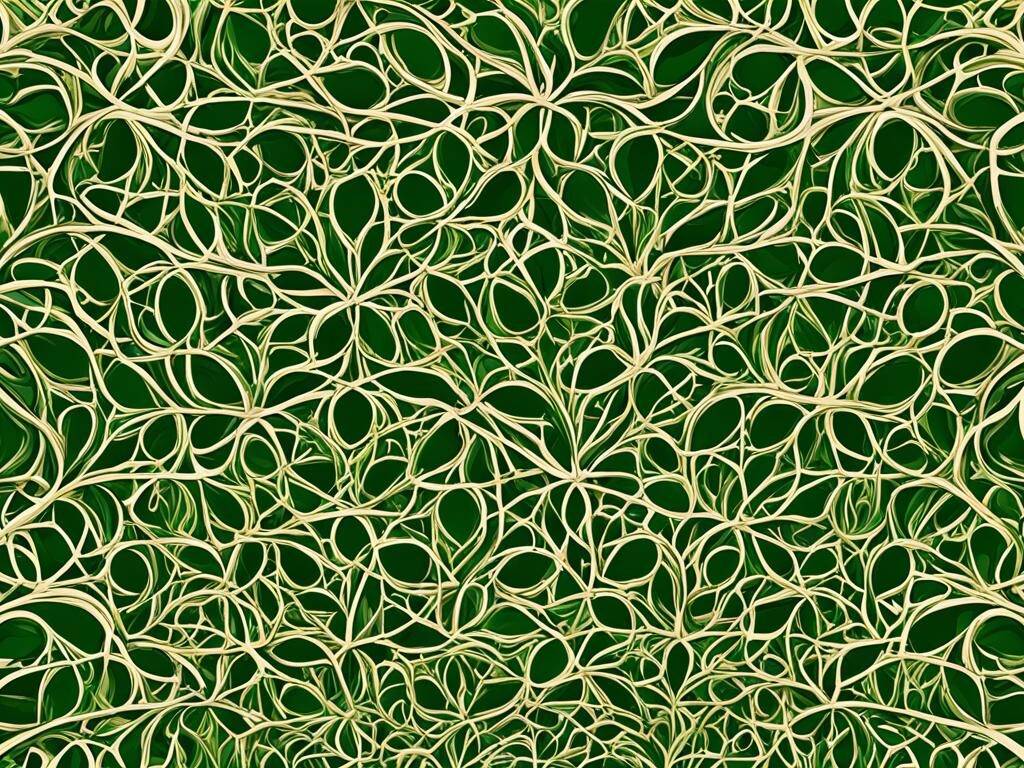
One famous example of a fractal is the Mandelbrot set. This mathematical object, named after Benoit Mandelbrot, is created by iterating a simple equation and plotting the results on a complex plane. The resulting image displays intricate and detailed patterns, revealing the hidden beauty of mathematical exploration.
The beauty of fractals lies in their ability to bridge the gap between the mathematical and natural worlds. They demonstrate the inherent interconnectedness of all things, reminding us that the same patterns can be found on both the grandest and smallest scales.
The concept of fractals has also made its way into various artistic expressions. Artists often use fractal-generating software to create stunning visual representations of these mathematical wonders. These artworks not only exhibit intricate patterns but also convey a sense of awe and wonder at the underlying mathematical principles.
Now let’s take a closer look at how fractals are formed and explore their mesmerizing patterns through a detailed table:
| Fractal Type | Examples in Nature |
|---|---|
| Koch Snowflake | Snowflakes, crystals |
| Sierpinski Triangle | Mountain ranges, river networks |
| Dragon Curve | Coastlines, lightning bolts |
| Julia Set Fractal | Flower petals, fern leaves |
As you can see, fractals are abundant in nature, manifesting in diverse forms and shapes. These intricate patterns not only inspire awe and wonder but also hold profound insights into the underlying mathematical principles that govern our world.
The Spiritual Significance of Sacred Geometry
Embark on a journey into the spiritual dimensions of sacred geometry, and unlock the profound connection it holds to higher consciousness. Throughout history, ancient civilizations have recognized the power of geometric principles in creating sacred spaces and enhancing spiritual practices. By delving into the world of spiritual geometry, we gain a deeper understanding of the sacred geometry meanings and the divine design present in the fabric of existence.
“Sacred geometry is not just a study of shapes and patterns; it is a gateway to the divine. It offers us a visual language to explore the mystical connection between the physical and the spiritual realms.” – Emma Smith, Spiritual Geometrist
At its core, spiritual geometry goes beyond the superficial aesthetics of geometric patterns. It invites us to perceive and experience the underlying unity and interconnectedness of all things. Through sacred geometry, we can tap into the fundamental principles that govern the cosmos and align ourselves with the greater cosmic order.
Ancient temples, such as the Great Pyramids of Egypt and the Gothic cathedrals of Europe, were meticulously designed using sacred geometric principles to evoke a sense of divine energy and facilitate spiritual experiences. These architectural marvels were not only physical structures but also gateways to transcendence, built upon the understanding that geometric shapes and ratios can amplify our spiritual connection and elevate our consciousness.
By meditating upon sacred geometric symbols, such as the Seed of Life, Flower of Life, and Sri Yantra, individuals have sought spiritual transformation and enlightenment. These symbols represent the underlying structure of the universe, believed to hold immense spiritual significance and divine wisdom.
Throughout spiritual traditions, mandalas have been used as tools for meditation and self-reflection. Mandalas, with their intricate geometric patterns, create a sacred space for individuals to access higher realms of consciousness. By focusing on the symmetrical and harmonious designs, practitioners can experience a sense of unity and transcendence, transcending the limitations of the physical world.

As we explore the profound spiritual significance of sacred geometry, we begin to recognize that these geometric patterns are not merely abstract concepts but tangible gateways to understanding the divine. By aligning ourselves with the principles of sacred geometry, we can nurture our spiritual growth, expand our consciousness, and deepen our connection to the universe.
Key Takeaways:
- Sacred geometry holds deep spiritual significance and offers a gateway to higher consciousness.
- Ancient civilizations used sacred geometric principles in the design of sacred spaces to enhance spiritual practices.
- Sacred geometric symbols and mandalas serve as tools for meditation and self-reflection.
- By exploring and aligning with the principles of sacred geometry, we can deepen our spiritual connection and expand our consciousness.
The Healing Power of Sacred Geometry
Discover the transformative and soothing effects of sacred geometry in the realm of healing and balancing energies. The intricate geometric shapes and patterns associated with sacred geometry are believed to hold profound significance for the mind, body, and spirit.
Throughout history, various cultures have utilized sacred geometry as a tool for enhancing well-being and promoting a sense of harmony. By integrating these geometric principles into healing practices, individuals can tap into the inherent power and interconnectedness of the universe.
The Transformative Effects of Sacred Geometry
Specific geometric shapes, such as the flower of life, Metatron’s cube, and the Sri Yantra, are thought to possess unique energetic properties. These shapes are believed to resonate with the fundamental patterns found in nature, allowing individuals to align with the divine proportions and universal energy.
The sacred geometry of the Sri Yantra is revered for its ability to stimulate spiritual growth and facilitate meditation. Its intricate design is said to represent the interconnectedness of all creation, making it a powerful tool for expanding consciousness.
By meditating on or visualizing these sacred geometric patterns, individuals may experience a deep sense of tranquility and clarity. It is believed that these shapes can help remove energetic blockages, balance chakras, and promote overall well-being.
The Role of Natural Patterns
The healing power of sacred geometry extends beyond artificial symbols and artwork. Nature itself is a masterful creator of geometric patterns, and these natural formations have their own inherent healing properties.
For example, the intricate hexagonal structure of a snowflake or the spiraling pattern of a seashell reflects the universal presence of sacred geometry in the natural world. These patterns are not only aesthetically pleasing but also evoke a sense of awe and tranquility, allowing individuals to connect deeply with the divine order of the universe.
The Harmonizing Effect of Divine Proportions
Divine proportions, such as the golden ratio and Fibonacci sequence, play a significant role in sacred geometry and have a harmonizing effect on the mind, body, and spirit. These mathematical ratios appear in everything from the growth patterns of plants to the proportions of the human body.
When individuals engage with sacred geometry and align themselves with these divine proportions, they can access a state of balance and resonance. This harmony can lead to enhanced well-being, increased creativity, and a deeper connection to the sacred wisdom of the universe.

Exploring the healing power of sacred geometry opens a gateway to a realm of deep spiritual connection and transformative energy. By embracing the intricate geometric patterns found in both human creations and the natural world, individuals can tap into the universal wisdom and experience profound healing on multiple levels.
Applying Sacred Geometry in Everyday Life
Discover the ways in which you can incorporate sacred geometry into your daily life and tap into its transformative power. By embracing geometric shapes and nature-inspired designs, you can enhance your connection to the natural world and infuse your surroundings with harmony and balance.
Using Geometric Symbols
One simple way to incorporate sacred geometry is by using geometric symbols in your everyday life. These symbols hold deep spiritual and symbolic meanings and can serve as reminders of the interconnectedness of all things. Whether you choose to wear them as jewelry, have them as decor in your home, or incorporate them into your artwork, these symbols can bring a sense of harmony and resonance to your environment.
Arranging Spaces with Sacred Geometric Principles
The arrangement of your physical spaces can also be influenced by sacred geometric principles. From the layout of furniture to the placement of objects, consider incorporating geometric patterns that promote balance and flow. Harmonizing your environment in this way can create a sense of tranquility and positive energy.
| The Flower of Life | The Seed of Life | The Sri Yantra |
|---|---|---|
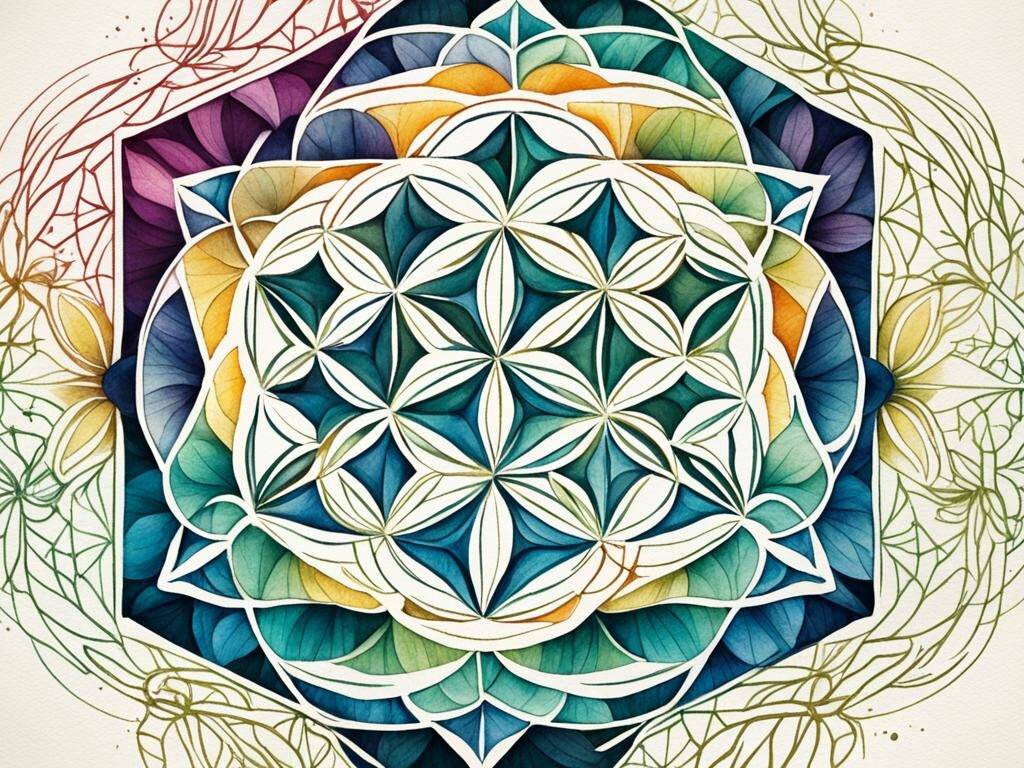 |
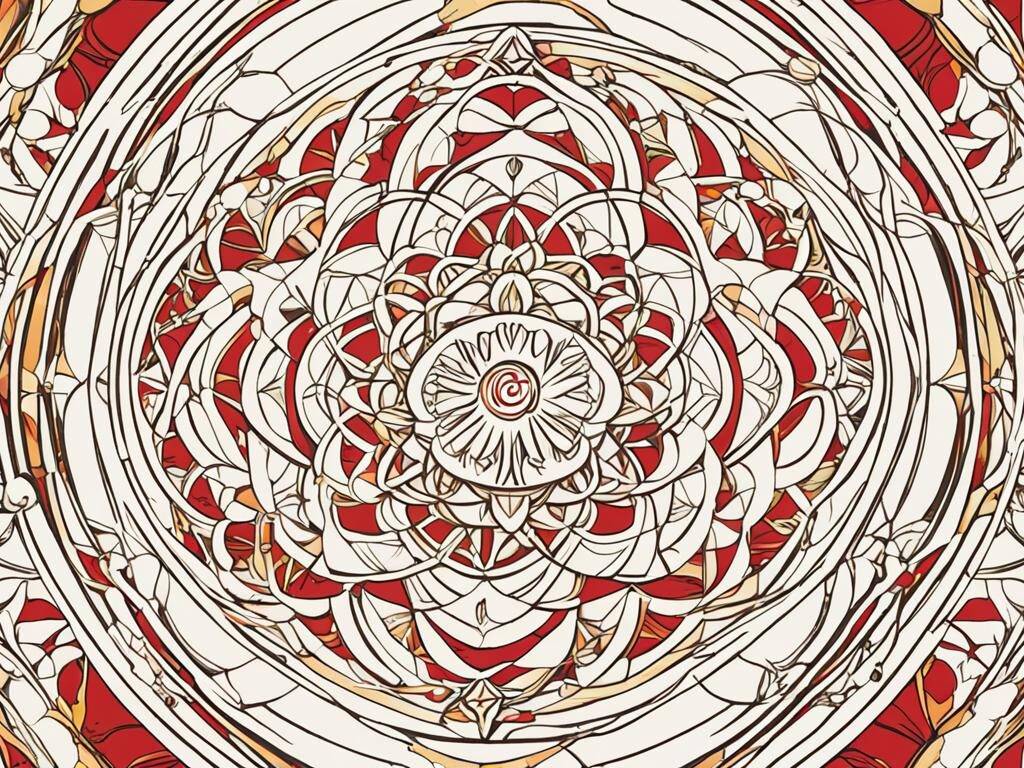 |
 |
Table: Examples of Sacred Geometric Symbols
Wearing Sacred Geometry Jewelry
By adorning yourself with sacred geometry jewelry, you carry the energy of these geometric patterns with you throughout the day. Whether it’s a pendant, ring, or bracelet, wearing sacred geometry jewelry can serve as a constant reminder of the beauty and interconnectedness of the universe.
“As above, so below; as within, so without.”
Embrace the wisdom of ancient philosophers like Hermes Trismegistus, who recognized the profound relationship between the inner and outer worlds. By integrating sacred geometry into your daily life, you align yourself with the natural rhythms of the universe and invite balance, harmony, and spiritual connection.
Modern Applications of Sacred Geometry
Contemporary artists, architects, and designers are increasingly incorporating the principles of sacred geometry into their work, finding inspiration in the harmony and beauty of natural patterns. From architecture to art, these modern applications of sacred geometry create visually stunning and spiritually meaningful designs.
One example of nature-inspired geometry in modern design is the use of fractals, which are self-repeating patterns found abundantly in nature. Architects are incorporating fractal-inspired structures that mimic the intricate branching of trees or the geometric repetition of snowflakes.
Fractals offer an opportunity to connect people with the natural world by recreating its intricate patterns in the built environment. They create a sense of harmony and rhythm, reflecting the mathematical principles that underlie our natural surroundings.
Contemporary sacred geometry art also plays a significant role in bringing these mathematical and spiritual concepts into the visual realm. Artists use sacred geometric shapes and symbols to explore universal truths and convey deep meaning in their work.
Mathematics in nature is another area where sacred geometry finds its modern applications. Scientists and mathematicians study the mathematical principles behind natural phenomena and use them to create innovative solutions in various fields, from engineering to environmental science.
Examples of Modern Applications of Sacred Geometry
Let’s take a closer look at some notable examples of modern applications of sacred geometry:
| Field | Application |
|---|---|
| Architecture |
|
| Art |
|
| Design |
|
These examples demonstrate how nature-inspired geometry and sacred geometry art are making an impact across various disciplines. By embracing the principles of mathematics in nature and incorporating them into their creations, artists, architects, and designers are able to tap into the inherent beauty and balance found in the natural world.
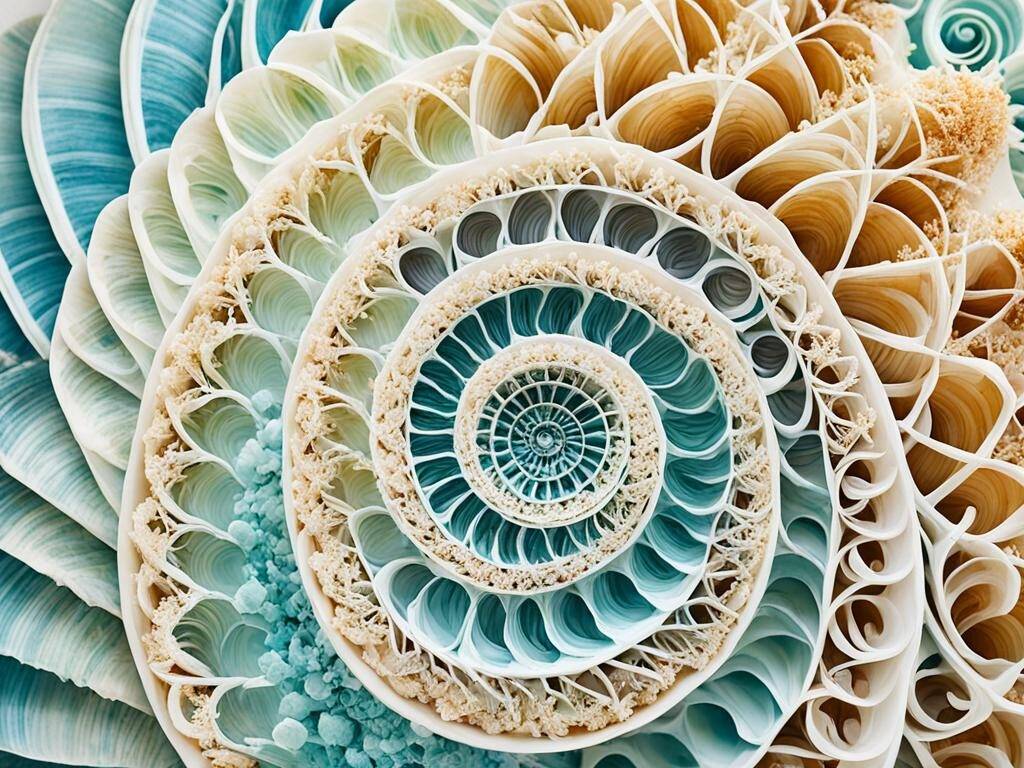
Nature’s Infinite Geometry
As we explore the fascinating world of sacred geometry, we come to realize that its influence extends far beyond human creations and architectural marvels. Nature itself is a masterful artist, weaving intricate patterns and geometric shapes throughout the fabric of existence. From the delicate petals of a flower to the majestic spirals of a seashell, the patterns of nature reveal a profound interconnectedness and unity.
Everywhere we look, we find sacred geometry embedded in the very fabric of reality. The ratios, proportions, and shapes that define these patterns echo the universal principles that govern the cosmos. By observing and studying these natural geometries, we gain insights into the profound beauty and harmony that shape our world.
Take a moment to contemplate the intricate mandala-like patterns found in the center of a blooming sunflower. Each petal is perfectly aligned, following a mathematical sequence known as the Fibonacci sequence, which creates a mesmerizing spiral pattern. This intricate formation not only captivates our visual senses but also serves as a reminder of the divine design that underlies all creation.

The organic symmetries and geometric precision found in the natural world are truly awe-inspiring. They reflect the inherent order and balance that exist beyond the superficial chaos of everyday life. Whether it’s the hexagonal cells of a beehive, the fractal branches of a tree, or the intricate patterns on a butterfly’s wings, nature’s infinite geometry speaks to the universal language of beauty and harmony.
In the words of philosopher and mathematician Pythagoras, “There is geometry in the humming of the strings, there is music in the spacing of the spheres.” Just as music is a profound expression of order and harmony, so too is sacred geometry a language through which the universe communicates its eternal truths.
By recognizing and appreciating the patterns of sacred geometry in nature, we tap into a deeper awareness of our place in the grand tapestry of existence. We begin to see that we are not separate from the natural world, but rather intimately connected to it, woven into its intricate fabric.
The Sublime Geometries of Nature
To further illustrate the captivating geometries found in nature, let’s delve into a particular example: the mesmerizing hexagonal structure of a snowflake. Each snowflake is a unique masterpiece, consisting of tiny ice crystals that form into breathtaking symmetrical shapes. These hexagonal patterns arise from the inherent properties of water molecules and the way they arrange themselves as they freeze.
This astonishing symmetry is not limited to snowflakes alone. Beehives, honeycombs, and even the structure of DNA exhibit the same hexagonal shapes, demonstrating the pervasive presence of sacred geometry in the natural world.
Let’s explore this example further with a table showcasing the remarkable similarities between the structures of snowflakes, honeycombs, and DNA:
| Snowflakes | Beehives and Honeycombs | DNA |
|---|---|---|
| Consist of symmetrical hexagonal patterns | Composed of hexagonal cells | Double helix structure with repeating patterns |
| Each snowflake is a unique, intricate design | Cells are perfectly aligned and interlocked | Genetic information encoded in its structure |
| Reflects perfect symmetry and balance | Efficient storage and utilization of space | Blueprint for life and the expression of hereditary traits |
Through these striking comparisons, we can see how sacred geometry manifests itself across different realms of existence, from the macroscopic to the microscopic. It beckons us to contemplate the interconnectedness of all things and to marvel at the profound wisdom encoded in the fabric of our universe.
As we conclude our exploration of nature’s infinite geometry, let us be reminded of the beauty, harmony, and interconnectedness that surround us. From the spiraling galaxies in the night sky to the delicate patterns on a leaf, sacred geometry whispers a timeless truth: that we are all connected, and the divine design that shapes the universe resides both within and around us.
Conclusion
In conclusion, the study of sacred geometry and the patterns found in nature reveals a mesmerizing tapestry of divine design. These intricate geometric patterns reflect a deeper symbolic and spiritual meaning, connecting us to the very essence of the universe.
By embracing the principles of sacred geometry and recognizing the presence of geometric patterns in nature, we gain a profound understanding of the interconnectedness and harmony that permeates our world. It is through this understanding that we can cultivate a deeper appreciation for the beauty and order that surrounds us.
Whether it is the Golden Ratio found in the growth patterns of plants or the self-similar fractals that appear in snowflakes and galaxies, the prevalence of sacred geometry in the natural world is undeniable. This ancient knowledge not only enriches our artistic and architectural endeavors but also provides a gateway to spiritual growth and healing.
As we incorporate sacred geometry into our daily lives, we tap into the transformative power of these geometric shapes and symbols. From arranging our spaces according to sacred geometric principles to wearing sacred geometry jewelry, we can enhance our connection to the natural world and align ourselves with the harmonious rhythms of the universe.

